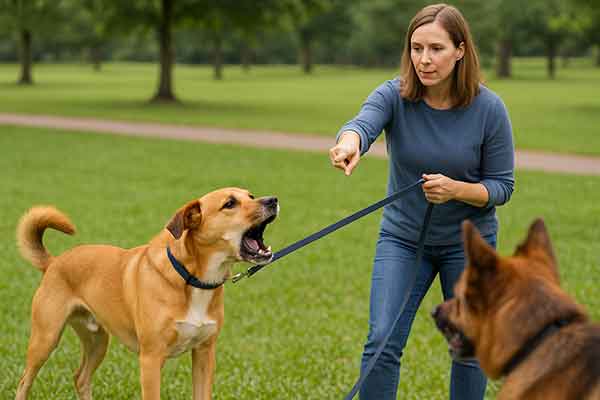Why Does My Dog Bark at Other Dogs? Causes, Tips & Training Advice
If your dog barks excessively at other dogs during walks or at the dog park, you’re not alone. One of the most common concerns among dog owners is “Why does my dog bark at other dogs?” Whether it’s excitement, fear, territorial behavior, or a lack of socialization, there are several reasons behind this noisy reaction. In this guide, we’ll break down the causes of dog-to-dog barking, when to be concerned, and effective ways to manage and train your dog to stay calm and quiet around other pups.
Table of Contents
- Is It Normal for Dogs to Bark at Other Dogs?
- Common Reasons Dogs Bark at Other Dogs
- Types of Barking Behavior in Dogs
- Is Barking Always a Sign of Aggression?
- How to Stop a Dog from Barking at Other Dogs
- Training Techniques to Reduce Reactivity
- When to Seek Professional Help
- FAQ
Is It Normal for Dogs to Bark at Other Dogs?
Yes, barking at other dogs is normal dog behavior. Barking is one of the primary ways dogs communicate, and it can mean anything from excitement to warning. However, excessive, intense, or uncontrollable barking may indicate an underlying behavioral or emotional issue that needs addressing through training and socialization.
Common Reasons Dogs Bark at Other Dogs
Understanding the “why” is the first step toward correcting the behavior. Here are the most common causes:
1. Excitement or Overstimulation
Many dogs bark when they see another dog out of excitement. This is especially true for high-energy or social dogs who want to play but don’t know how to stay calm during initial greetings.
2. Fear or Anxiety
A fearful or anxious dog may bark as a defensive reaction. If your dog has had a bad experience with another dog, they may try to bark to keep others away.
3. Territorial or Protective Behavior
Some dogs bark at other dogs who get too close to their home, yard, or even their owner. This is usually a territorial response and can also include lunging or growling.
4. Lack of Socialization
Dogs who haven’t been properly socialized may not know how to interact with other dogs. Barking becomes their default way to cope with the unfamiliar situation.
5. Leash Reactivity
Some dogs only bark at other dogs while on a leash, a condition known as leash reactivity. This is often caused by the frustration of not being able to greet freely or the tension of being restrained.
6. Attention-Seeking Behavior
If barking gets your attention—or the attention of the other dog—your pup may use it intentionally as a way to get noticed.
7. Learned Behavior
If barking at other dogs has worked in the past (e.g., the other dog leaves), your dog may repeat the behavior because they’ve learned it’s effective.

Types of Barking Behavior in Dogs
Recognizing the type of bark can help you decode your dog’s motivation:
- High-pitched, fast barks: Usually linked to excitement or eagerness
- Low, sustained barks: Often a sign of warning or fear
- Single bark with body tension: Indicates alertness or challenge
- Rapid barking with growling: May suggest a more serious threat perception or frustration
Is Barking Always a Sign of Aggression?
No, barking is not always aggressive. Many dogs bark without any aggressive intention. The key is to observe body language:
- Excitement or friendly greeting
- Tense body, raised hackles, direct eye contact: Potential aggression or fear
- Cowering or backing away while barking: Fear-based reactivity
How to Stop a Dog from Barking at Other Dogs
Here are practical steps to reduce your dog’s barking behavior:
1. Avoid Triggers During Early Training
Manage the environment by walking during quiet times or avoiding dog parks until training progresses. This prevents reinforcing bad habits.
2. Teach the “Look at Me” or “Focus” Command
Train your dog to look at you on cue. This helps redirect their attention away from other dogs and back to you.
3. Use Distance as a Reward
When your dog stays calm at a distance from another dog, reward them and slowly reduce the distance over time. This technique is known as desensitization.
4. Use High-Value Treats
Bring along tasty treats your dog loves and use them to reinforce quiet, calm behavior when they see another dog.
5. Avoid Punishment
Yelling or using harsh corrections can increase fear or anxiety, worsening the problem. Focus on positive reinforcement instead.
Training Techniques to Reduce Reactivity
Counter-Conditioning
Pair the sight of other dogs with positive experiences like treats or play to change your dog’s emotional response.
BAT (Behavior Adjustment Training)
A technique that helps dogs learn how to make better choices in social situations by rewarding calm behavior and offering distance when needed.
Clicker Training
Use a clicker to mark calm behaviors followed by a reward. This helps your dog understand exactly what behavior earns praise.
Impulse Control Games
Games like “leave it,” “wait,” or “stay” build patience and focus, helping your dog remain calm when overstimulated.
When to Seek Professional Help
If your dog’s barking is:
- Intensely aggressive
- Accompanied by lunging or snapping
- Causing safety concerns
- Not improving with consistent training
Then it’s time to contact a certified dog trainer or animal behaviorist. They can assess your dog’s triggers and create a custom behavior plan.
FAQ
Is it bad if my dog barks at other dogs?
Not necessarily. Occasional barking is normal. But frequent or intense barking could indicate reactivity, anxiety, or a need for more training and socialization.
Will my dog grow out of barking at other dogs?
Some dogs mellow with age, but most barking habits continue without intervention. Early training and socialization are key.
Can neutering reduce barking at other dogs?
In some cases, yes—especially if the barking is related to territorial or hormonal behavior. But training is still essential.
Is dog-on-dog barking dangerous?
It can be, especially if it escalates into aggression. But most barking is harmless communication unless paired with threatening body language.
How long does it take to train a dog to stop barking at other dogs?
It depends on your dog’s personality, age, and training consistency. With daily practice, many dogs show improvement within weeks, while others may take months.
Conclusion
Why does my dog bark at other dogs? The answer lies in a mix of instinct, emotion, and learned behavior. Whether your dog is excited, afraid, or simply untrained, barking at other dogs is a common and fixable behavior. With patience, understanding, and the right training techniques, you can help your dog feel more comfortable and confident around other dogs—leading to quieter walks and a happier pup.
If your efforts at home aren’t enough, don’t hesitate to seek the help of a professional trainer. The journey to a well-behaved, calmer dog starts with you!


